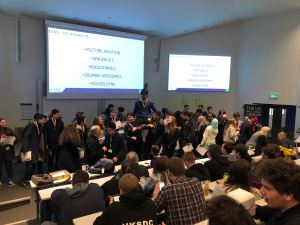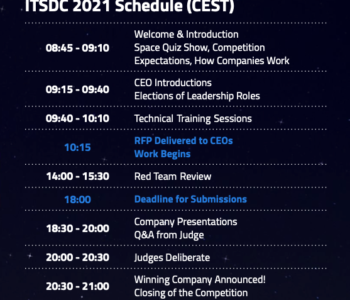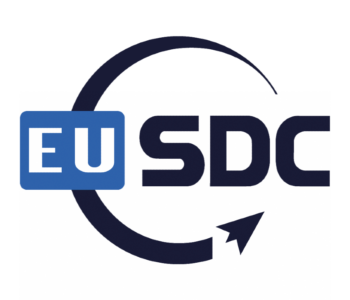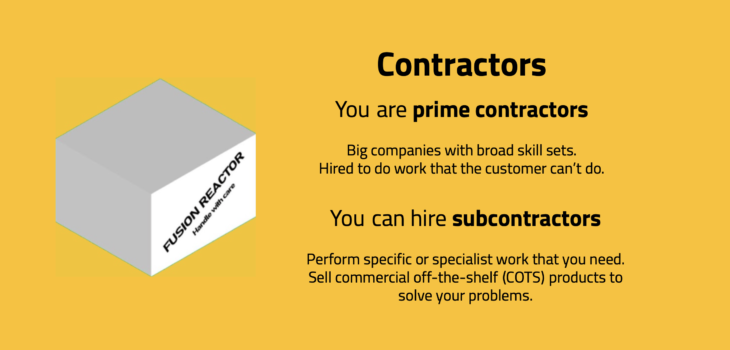 Explainers
Explainers
#5: Prime & Subcontractors
Word count & reading time: (1280 words – 10 minutes)
Welcome back to the Space Design Competitions – unique, impactful, and exhilarating space STEAM-a-thon events that get you conceptually designing space habitats for up to 80 years in the future…
The last article elaborated on the details of the Company Structure and roles within them. Prime and Subcontractors were introduced and are often a stumbling block for most first-time participants. As such, we’ll dive into it here as these concepts are integral to the Space Design Competitions.
If you have not already, take a minute to watch this video reviewing 14 years of the UKSDC event. It gives a great overview of what we’re all about.
What is a contractor?
A great place to start. What is a contractor and what do they have to do with industry? Before we jump into contractors, let us first acknowledge the root word: contracts.
You may be familiar with what a contract is as you have probably got your phone data & call package on some form of contract, or are aware of contracts with utility providers (e.g. internet, electricity, water, or gas) for your home. But what is a contract?
A contract is a formal written —or spoken— agreement, especially one concerning employment, sales, or tenancy, that is intended to be enforceable by law.
It’s essentially an agreement between two or more parties regarding work to be done. It should now make a lot more sense when you read the definition for a contractor below.
A contractor is an individual or firm that agrees to the terms of a contract and provides materials or labour to perform the service or fulfil the job as stated in the contract.
In essence, a contract is the agreement and the contractors are those fulfilling the terms of the agreement for the client. This is the bread-and-butter of modern day industry (especially the space sector!), describing how it operates efficiently and effectively.
A client is an individual or firm using the services of another professional individual or firm, the owner of the job stated in a contract.
Picture yourself as the owner of an electronics shop. You may not have the skills within your shop to perform interior refurbishment. Desperately needing to upgrade the interior of your shop for new electronic hardware, you decide to hire specialists to perform these specific tasks. In this example, you —the business owner— are the client and the specialists are the contractors. It’s as simple as that!
If you haven’t quite understood this concept yet, give it some time to set in as the rest of the article will go into further detail about the various types of contractors.
What is a Prime Contractor?
The word “prime” is often given to an individual or entity that is of importance: the main entity. So in the case of contractors, the Prime Contractor is the main contractor.
In very large projects (such as building a space settlement) there exists a wide array of skills and specialisations needed to complete the entire project. In such cases, you will need to hire many different subcontractors. But who manages them all?
The Prime Contractor is the lead contractor responsible for the completion of a project which is under contract with the owner of the job (the client). The obligation of the prime contractor is to complete a project and can hire multiple other contractors (subcontractors) to do the same.
So the prime contractor is the company that the client puts in charge of overseeing the execution of a project.
In the case of the SDCs, the company that you are a member of is a prime contractor. There are five different companies in the SDCs, each battling to win the client’s trust —by creating the most attractive design proposal— to be awarded the contract. This is the basis of the Space Design Competitions.
The five different prime contractors are listed below (their specialisations are accessible here):
- Kepler Automation
- Olympus Mons Trading Company
- Earhart Advanced Industries
- DaVinci Meccanica
- Condor Aviation
What is a Subcontractor?
You have probably guessed it already. A subcontractor is just another contractor in the larger project who fulfils a small part of the whole.
A subcontractor is an individual or a firm that signs a contract to perform part of the obligations of another’s contract.
You would often hire subcontractors either to reduce costs, save time, or to mitigate project risks. In employing subcontractors, the prime contractor hopes to receive the same or better service than the prime contractor could have provided by itself at lower overall risk. Remember the example of the electronics shop?
In the SDCs, there are a tonne of subcontractors that you —a member of a prime contractor— can and should use in your design proposal. Each has a specialisation that may prove beneficial to you. The judges will be looking out for effective use of subcontractors to reduce project costs, timelines, and risks.
The idea of offloading your work to someone else may seem alien to you as this is not typically practised in school. Well, that’s just another reason you should take part in an SDC! We’re here to show you how industries work.
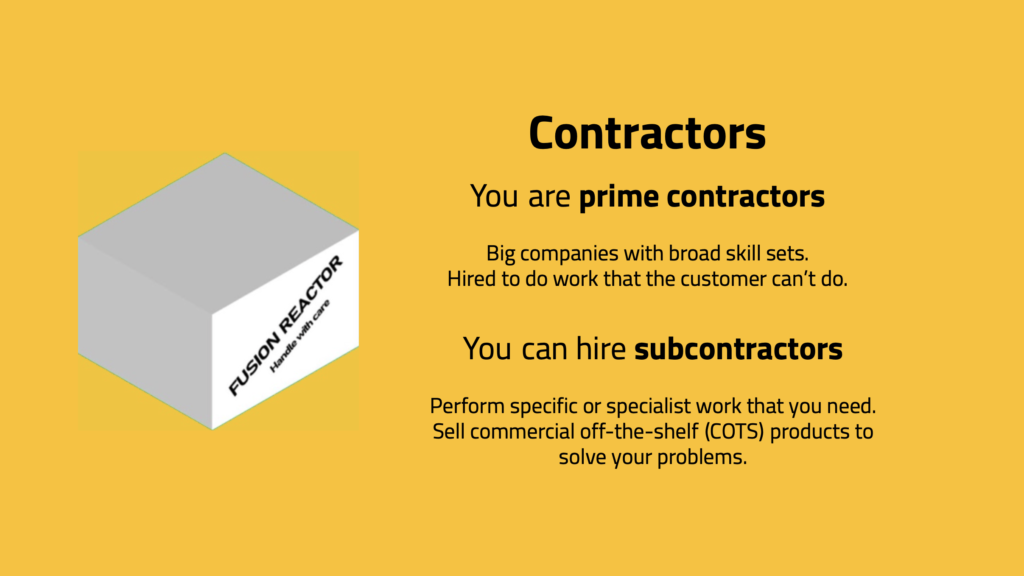
An SDC Example
You now know that in the SDCs you are a member of one of the companies (a prime contractor) competing to win a contract with the Foundation Society (the client) to build a space settlement. In this setting, you are encouraged and expected to use someone else’s specialisations (subcontractors) to fulfil a part of your design proposal. All right, let’s put this together in a typical SDC example.
You are a member of the Human Engineering department of Earhart Advanced Industries (a prime contractor). The Foundation Society (the client) has specifically listed a nutritional requirement for a varied, fresh, and balanced diet for the inhabitants.
Your department decides that fish is a tasty source of protein, fatty acids, and an assortment of vitamins and minerals. You also note that growing fish means you can offer ecological habitats on your settlement that resemble Earth, improving the mental health of the inhabitants. Great! But you have absolutely no clue how to farm fish.
Your first point-of-call is to check the list of subcontractors. Low and behold, CRISPR Cod is an organisation that sells, despite their name, a large variety of genetically modified fish that they claim are guaranteed to provide greater yields of produce with greater resistance to parasites and diseases.
You enlist CRISPR Cod’s services, noting how much it will cost. Simple as that.
Here, you isolated a subcontractor that can perform the work you need and enlisted their services. In your final design proposal, all you need to do is state the use of the subcontractor, how much it will cost you, and how the provision of their services will make your settlement desirable to the client.
Congratulations, you’re one step closer to being SDC ready!
Final Remarks
The notion of contractors is of fundamental importance to the space sector. I hope you now have a deeper understanding of how they work and how you can utilise this knowledge in the SDCs.
Next up, I will do my best to give you the skills necessary to decipher the Request for Proposal (RFP); the central document to all SDCs. It will be a 3-part series as there is much to cover…
Thanks for reading, and stay tuned for more!
External Links
- Want to get involved in this rapidly growing network of space education enthusiasts? Register your interest to volunteer here: eusdc.org/volunteer-registration
- Want to follow the news and events in the European context? Check out the EUSDC website here: eusdc.org
- Want to find out more about the organising charity? Check out the SSEF website here: ssef.org.uk

